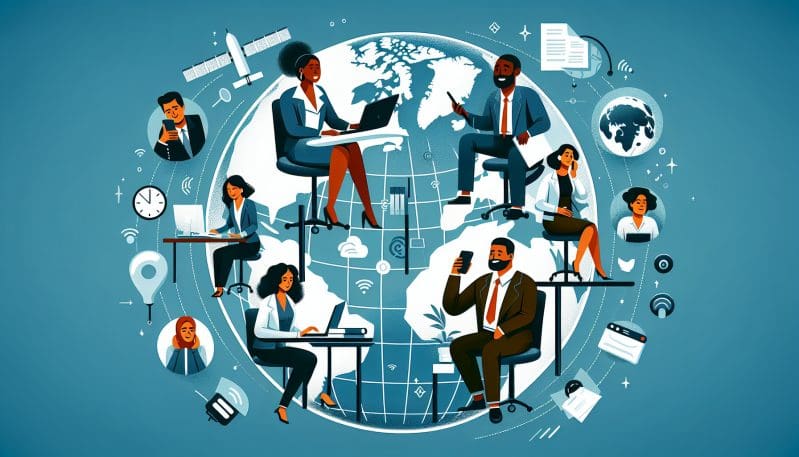Redefining Job Accessibility: Bridging the Digital Divide for Global Workforce Inclusion
- Home
- Redefining Job Accessibility: Bridging the Digital Divide for Global Workforce Inclusion
- Editors Desk
- March 6, 2024
- 0 Comments
In an era where technology dictates the pace and structure of employment, the concept of job accessibility takes on new dimensions. The digital divide, a term that describes the gap between those who have ready access to computers and the internet and those who do not, has become a critical barrier to entry into the global workforce. With each technological leap, we risk creating a greater chasm between the ‘haves’ and the ‘have-nots,’ thus undermining the strides we’ve made towards a more inclusive and equitable job market.
No Worker Left Behind (NWLB) stands at the forefront of this challenge, much like the World Economic Forum, but with a keen focus on sectors and demographics that are often overlooked. NWLB’s mission dovetails with the need for intervention and innovation in addressing the digital divide, ensuring that every worker, regardless of their socio-economic background, has the opportunity to participate in the evolving work landscape.
The Imperative for Collaboration
To effectively bridge this divide, collaboration across various sectors is imperative. Governments have the power to enact policies that incentivize or directly support the expansion of digital access. This includes funding for infrastructure in underserved areas, subsidies for personal computing devices and internet services, and grants for educational institutions to update curriculum and resources to meet the needs of the digital age.
Businesses, on the other hand, can shoulder corporate responsibility by investing in training programs for their employees, offering internships or apprenticeships to underrepresented communities, and partnering with educational institutions to create a pipeline of digitally literate talent. It is in the interest of businesses to have a workforce that is adaptable and skilled in digital competencies, not just to enhance productivity but also to foster a culture of innovation and inclusivity.
Educational institutions are the crucibles where the workforce of the future is shaped. By integrating digital skills into their curriculum, schools and universities can ensure that their graduates are not only adept at the tools of today but are also prepared to evolve with the tools of tomorrow. Moreover, lifelong learning programs can help current workers stay abreast of technological advancements.
NWLB’s Contribution to Digital Inclusion
As part of its commitment to an inclusive workforce, NWLB spearheads a range of initiatives designed to close the digital gap. We provide resources and advocacy for policy reform that emphasizes the importance of digital literacy as a fundamental right. We partner with tech companies to create accessible training modules for digital tools and software that are critical in today’s job market. Furthermore, NWLB supports grassroots movements that aim to bring technology to underserved communities, be it through mobile computer labs or community internet access points.
Case Studies: A Glimpse of Success
Take, for example, the case of a rural community in Southeast Asia where internet penetration was less than 10%. Through a collaboration of local government, a multinational tech firm, and NWLB, an initiative was launched to provide community internet hubs equipped with training facilities. Within two years, not only did internet usage rates climb to over 60%, but local businesses reported an uptick in productivity and revenue thanks to their newly acquired digital capabilities.
In another instance, NWLB worked with a coalition of employers in the service industry to develop a digital training curriculum designed for potential job seekers with minimal digital experience. This endeavor led to the employment of over 5,000 individuals who, pre-training, lacked the qualifications to compete in a digitally-driven job market.
Challenges and Opportunities Ahead
Despite successful stories, challenges persist. Infrastructure can be prohibitively expensive; educational reforms can be slow to implement; and business interests don’t always align with social good. However, with the shared goal of a diverse and inclusive workforce, each challenge is an opportunity—an opportunity to innovate, to partner, to learn, and ultimately, to build a global jobs strategy that leaves no worker behind.
As we look to the future, the synergy between policy, education, and business is not just beneficial but necessary. Driving this synergy is NWLB, championing the cause of a world where the digital economy is all-encompassing and job accessibility is not a privilege but a norm.
As stakeholders in the global workforce, we have a responsibility to dismantle the barriers created by the digital divide. Every step we take towards digital inclusion not only empowers individual workers but strengthens the economic and social fabric of our societies. It’s time to redefine job accessibility, and with NWLB, we can ensure that everyone has a fighting chance in this digital world.

